Key Takeaways:
- Jordan: An Iranian-backed militia conducted a one-way drone attack targeting US forces in northeastern Jordan, killing three American service members and wounding another 25. This attack is part of the ongoing Iranian-led campaign to expel US forces from the Middle East. The Iranian-backed attack highlights the growing prominence of Jordan in Iranian regional strategy.
- Northern Gaza Strip: The Israel Defense Forces 5th Brigade (assigned to the 143rd Division) located and destroyed a tunnel route.
- Central Gaza Strip: The Israel Defense Forces Nahal Brigade (assigned to the 143rd Division) clashed with Palestinian fighters.
- Southern Gaza Strip: The Israel Defense Forces withdrew the 4th (Kiryati) Brigade and 55th Paratrooper Brigade from Khan Younis.
- West Bank: Israeli forces clashed with Palestinian fighters in seven locations, primarily around Jenin.
- Southern Lebanon and Golan Heights: Iranian-backed fighters, including Lebanese Hezbollah, conducted six attacks from southern Lebanon into northern Israel.
- Iraq and Syria: The Islamic Resistance in Iraq—a coalition of Iranian-backed Iraqi militias—claimed responsibility for five attacks targeting US positions in Iraq and Syria.
An Iranian-backed militia conducted a one-way drone attack targeting US forces in northeastern Jordan on January 28, killing three American service members and wounding another 25.[i] This attack is part of the ongoing Iranian-led campaign to expel US forces from the Middle East. CTP-ISW has reported extensively in recent months on how Iranian-backed militias have used military and political pressure to catalyze a US withdrawal from Iraq and Syria.[ii] These militias have conducted over 170 attacks targeting US positions as part of this effort since October 2023.[iii] The militias have framed their attacks as responses to the Israel-Hamas war, when the attacks are in actuality part of the larger Iranian project in the Middle East. Iran and its so-called “Axis of Resistance” view the Israel-Hamas war as an opportunity to accelerate their campaign to expel US forces, as they have used the war to narratively justify their attacks.
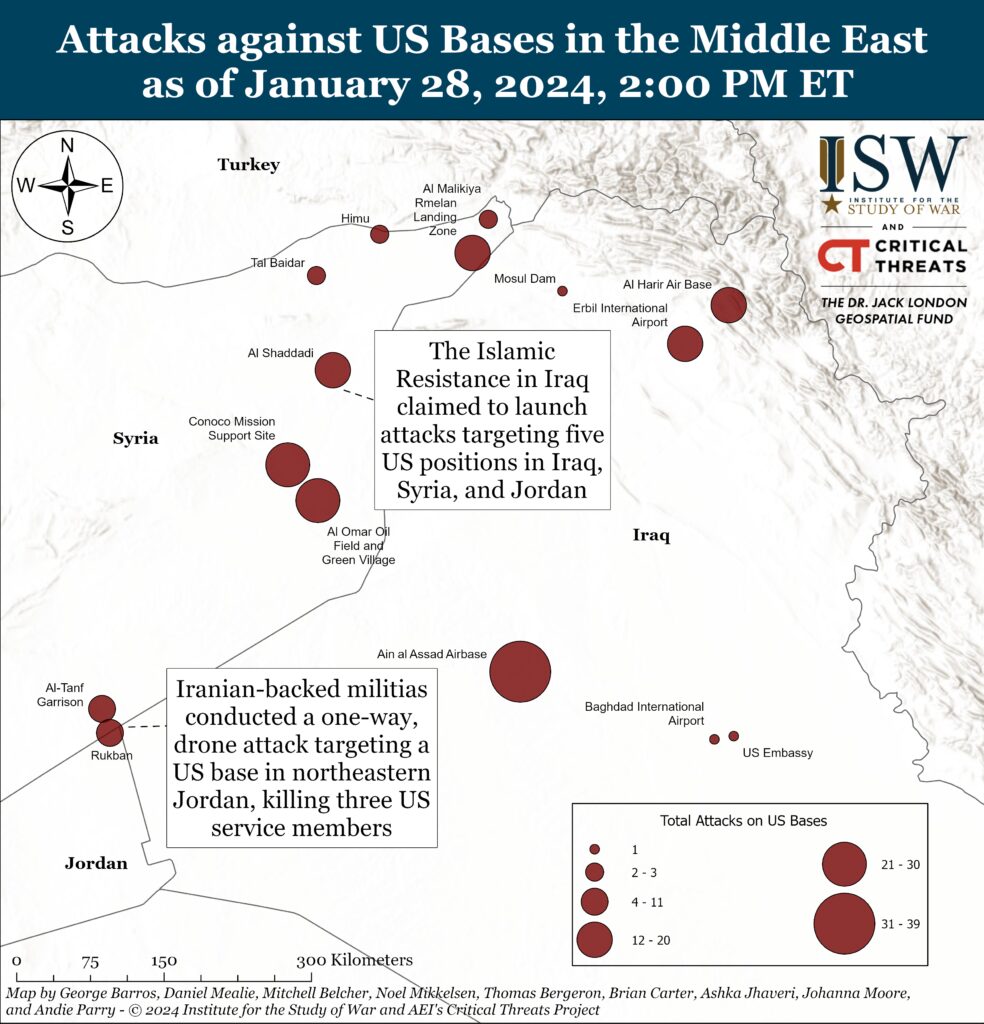
The Axis of Resistance is demonstrating its readiness to sustain and even further escalate its attack campaign, despite the United States and Iraqi federal government announcing that they will negotiate over the status of US forces in Iraq. US Defense Secretary Lloyd Austin announced on January 25 that Washington and Baghdad will soon hold “working group meetings” to evaluate the status of the US-led coalition mission to defeat the Islamic State in Iraq and Syria (ISIS).[iv] Such negotiations could precipitate the withdrawal of US forces from Iraq. The United States reportedly dropped a precondition requiring that Iranian-backed militias stop their attacks before such negotiations.[v] The Islamic Resistance in Iraq, a coalition of Iranian-backed militias, vowed on January 26 to sustain its attacks, asserting that the United States only understands “the language of force.”[vi]
Iranian-led efforts to expel the United States from Iraq would complicate sustaining a US force presence in Syria. US forces and military infrastructure in Iraq provide logistical support that enables the US force presence in Syria. The United States withdrawing from Iraq would therefore necessitate the withdrawal of many US forces from Syria. The Axis of Resistance could launch a concerted effort to expel US forces from Jordan to deprive the United States of another avenue from which it could support an American force presence in Syria.
The United States leaving Iraq and Syria risks allowing ISIS to resurge there. CTP-ISW continues to assess that the United States and its partners in Syria have successfully contained but not defeated ISIS and that a US withdrawal from Syria would very likely cause a rapid ISIS resurgence there within 12 to 24 months.[vii] A resurgent ISIS could then threaten Iraq. Iraqi security forces still face significant deficiencies in fire support, intelligence, and logistics that will impede their ability to defeat ISIS alone.[viii]
The Iranian-backed attack highlights the growing prominence of Jordan in Iranian regional strategy. Jordanian territory offers multiple ground routes through which Iran could move military materiel into the West Bank. Tehran has sought to develop its militia capabilities and infrastructure in the West Bank in recent years, but the Israel-Hamas war has highlighted Iranian shortcomings there.[ix] Recent clashes and Israeli raids in the West Bank have revealed that the Palestinian militias there remain relatively disorganized and still use rudimentary capabilities compared to the militias in the Gaza Strip. Iranian leaders could conclude that they need to invest further in building their networks into Jordan to develop their militia infrastructure in the West Bank more effectively. The Jordanian armed forces have conducted four airstrikes into Syria targeting Iranian-affiliated smuggling networks since the war began, suggesting either a change in Iranian-backed smuggling patterns and/or a change in Jordanian tolerance of them.[x] Iran likely directed the drone attack into Jordan partly to message to Jordanian leaders the capability and willingness of the Axis of Resistance to escalate.
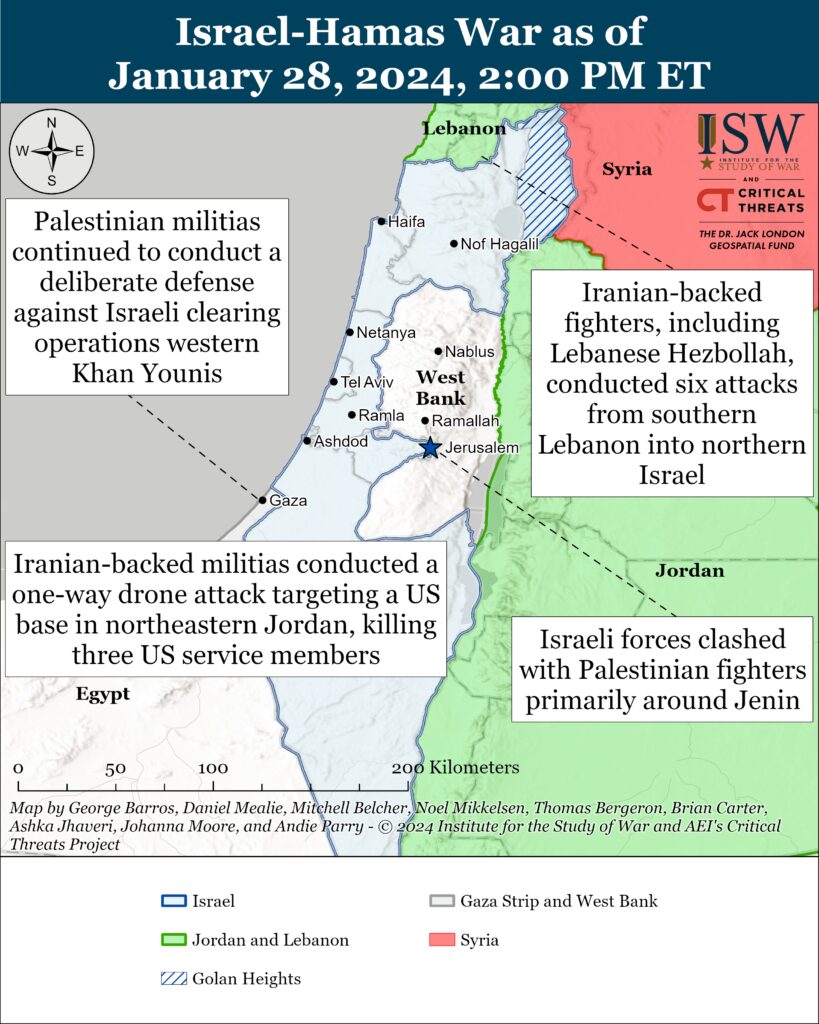
Gaza Strip
Axis of Resistance campaign objectives:
Erode the will of the Israeli political establishment and public to launch and sustain a major ground operation into the Gaza Strip
Degrade IDF material and morale around the Gaza Strip.The Israel Defense Forces (IDF) 5th Brigade (assigned to the 143rd Division) located and destroyed a tunnel route in the northern Gaza Strip on January 28.[xi] The Popular Front for the Liberation of Palestine (PFLP) separately mortared IDF armor and dismounted infantry east of Jabalia. Palestinian militias have likely reinfiltrated these areas around Jabalia and are contesting IDF raids there.[xii]
The IDF Nahal Brigade (assigned to the 143rd Division) clashed with Palestinian fighters in the central Gaza Strip on January 28.[xiii]
Palestinian militias continued to conduct a deliberate defense against Israeli clearing operations in western Khan Younis on January 28. Hamas and Palestinian Islamic Jihad (PIJ) fired rocket-propelled grenades (RPG) at Israeli armor and dismounted infantry in the al Amal neighborhood in western Khan Younis.[xiv] Other Palestinian militias are operating in western Khan Younis, including the al Aqsa Martyrs’ Brigades, which is the self-proclaimed militant wing of Fatah.[xv]
The IDF withdrew the 4th (Kiryati) Brigade and 55th Paratrooper Brigade from Khan Younis on January 28.[xvi] An Israeli Army Radio correspondent reported that the 646th Paratroopers Brigade (assigned to the 99th Division) is expected to deploy to Khan Younis. The 646th brigade is currently operating in the Central Governorate of the Gaza Strip.[xvii]
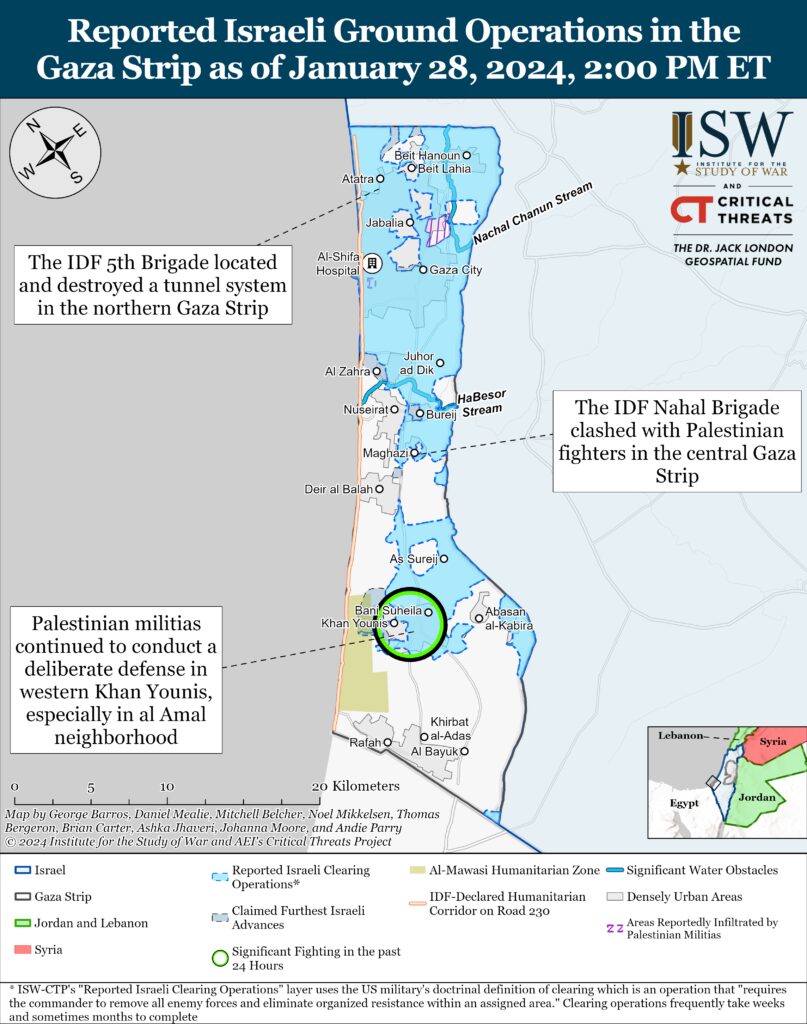
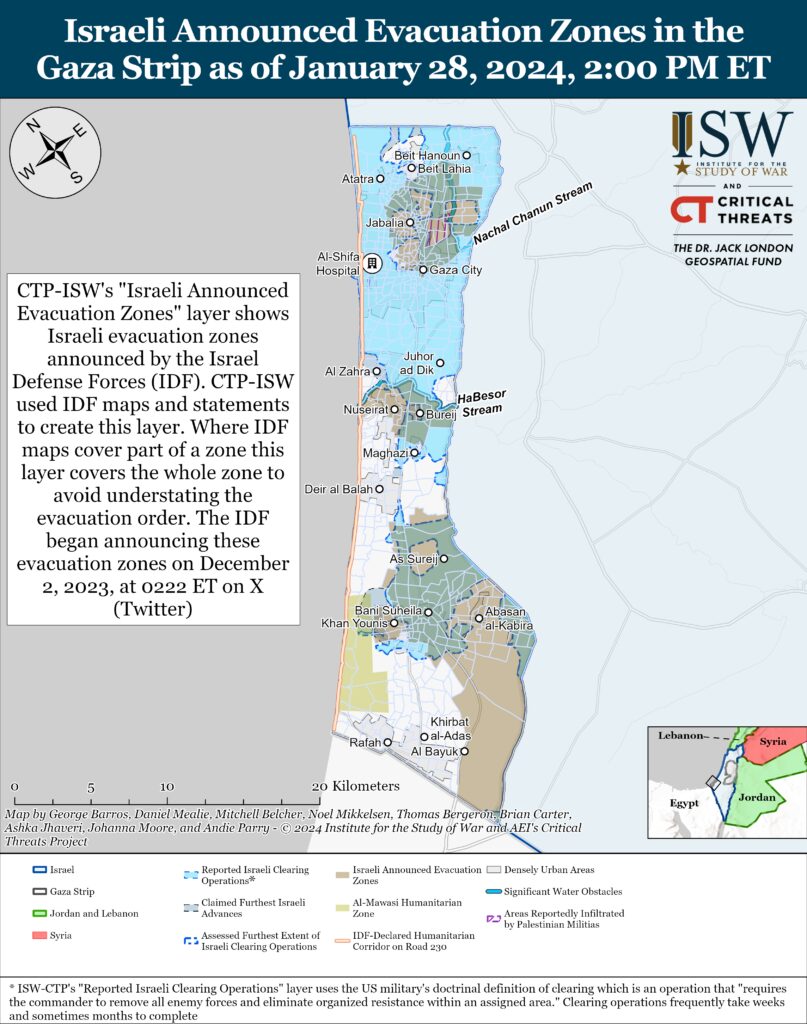
Israeli media reported that Palestinian militias have slightly increased in recent days the number of rockets attacks they are launching from areas where Israeli forces operated previously in the northern Gaza Strip.[xviii] The launches demonstrate that Palestinian militias in the northern Gaza Strip retain some ability to fire rockets into Israel, despite Israeli operations. CTP-ISW previously reported that Hamas fighters are reinfiltrating areas that Israeli forces cleared in the northern Gaza Strip, which will facilitate Hamas’ reconstitution.[xix] Israeli media speculated that the IDF could be leaving a power vacuum by exiting without designating a Palestinian civil authority to govern in areas of the northern Gaza Strip. Israeli media further reported there is growing fear amongst Israeli military leadership that Hamas will be able to reconstitute in these areas.
The Wall Street Journal (WSJ) reported that as much as 80 percent of Hamas’ tunnels remain intact in the Gaza Strip.[xx] The tunnels run for over 300 miles underneath the Gaza Strip. The New York Times reported on January 16 that the IDF now believes that there are more tunnels underneath the Gaza Strip than previously thought.[xxi]
Palestinian fighters fired three rocket salvos from the Gaza Strip into Israel on January 28.[xxii]
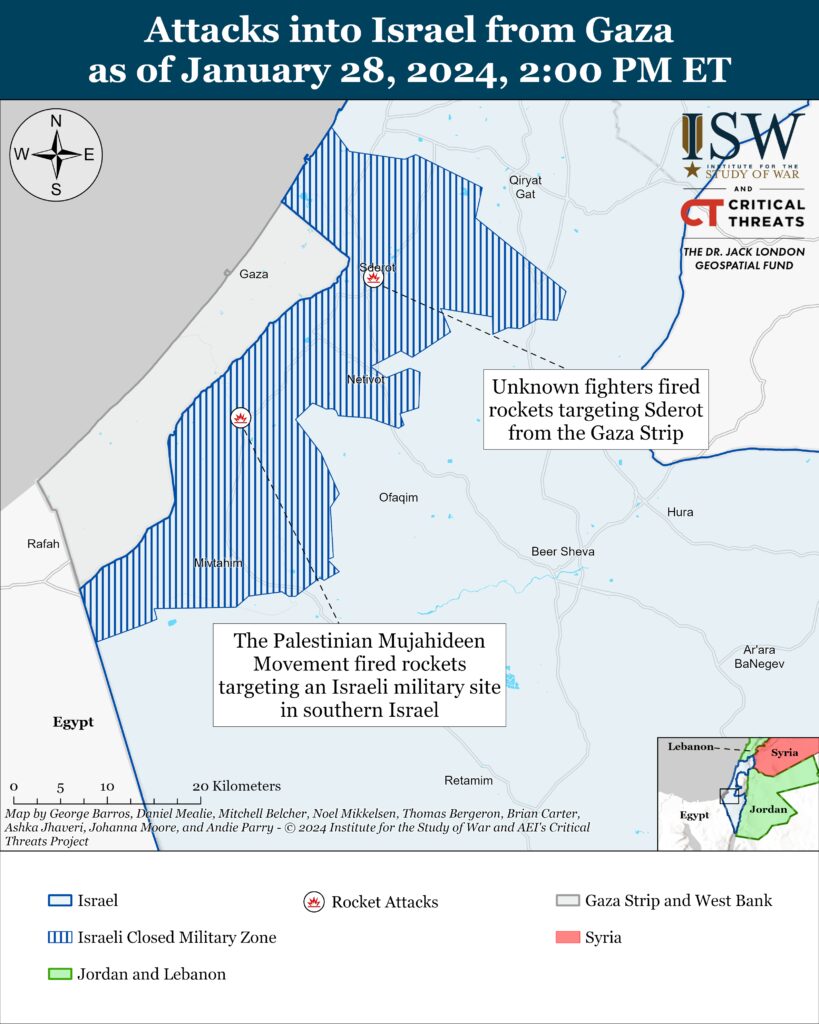
Recorded reports of attacks; CTP-ISW cannot independently verify impact.
West Bank
Axis of Resistance campaign objectives:
Draw IDF assets and resources toward the West Bank and fix them thereIsraeli forces clashed with Palestinian fighters in seven locations across the West Bank, primarily around Jenin.[xxiii]
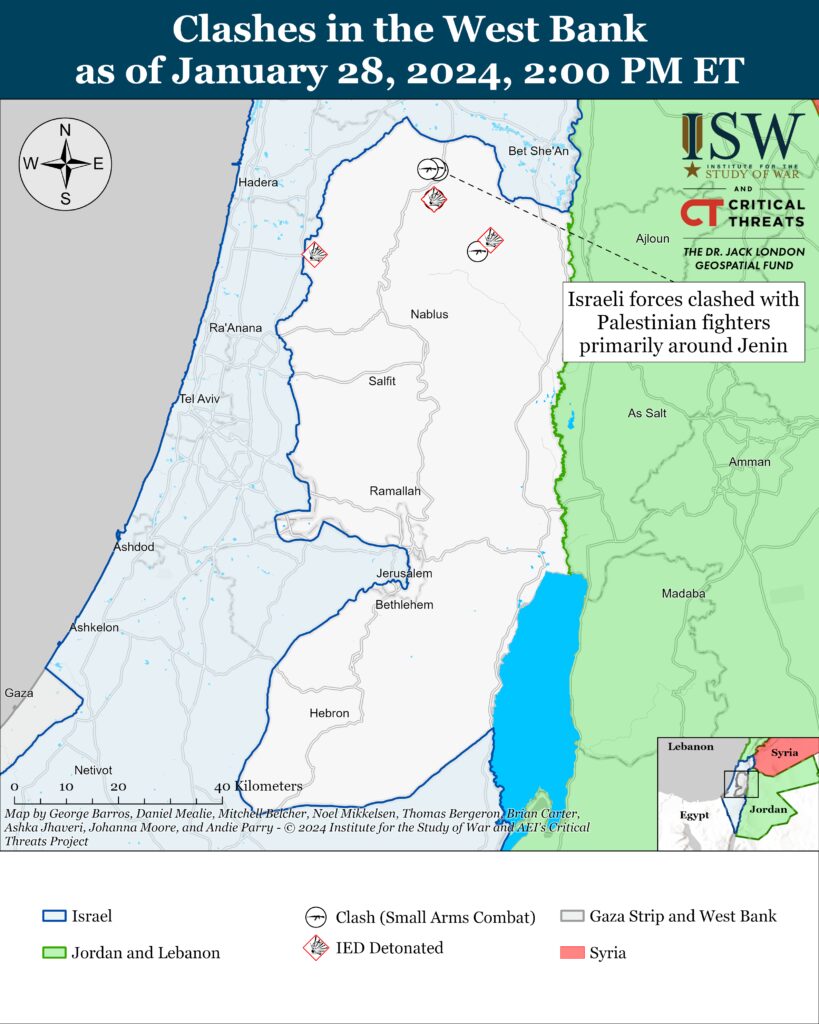
This map is not an exhaustive depiction of clashes and demonstrations in the West Bank.
Southern Lebanon and Golan Heights
Axis of Resistance campaign objectives:
Draw IDF assets and resources toward northern Israel and fix them there
Set conditions for successive campaigns into northern IsraelIranian-backed fighters, including Lebanese Hezbollah, conducted six attacks from southern Lebanon into northern Israel on January 28.[xxiv]
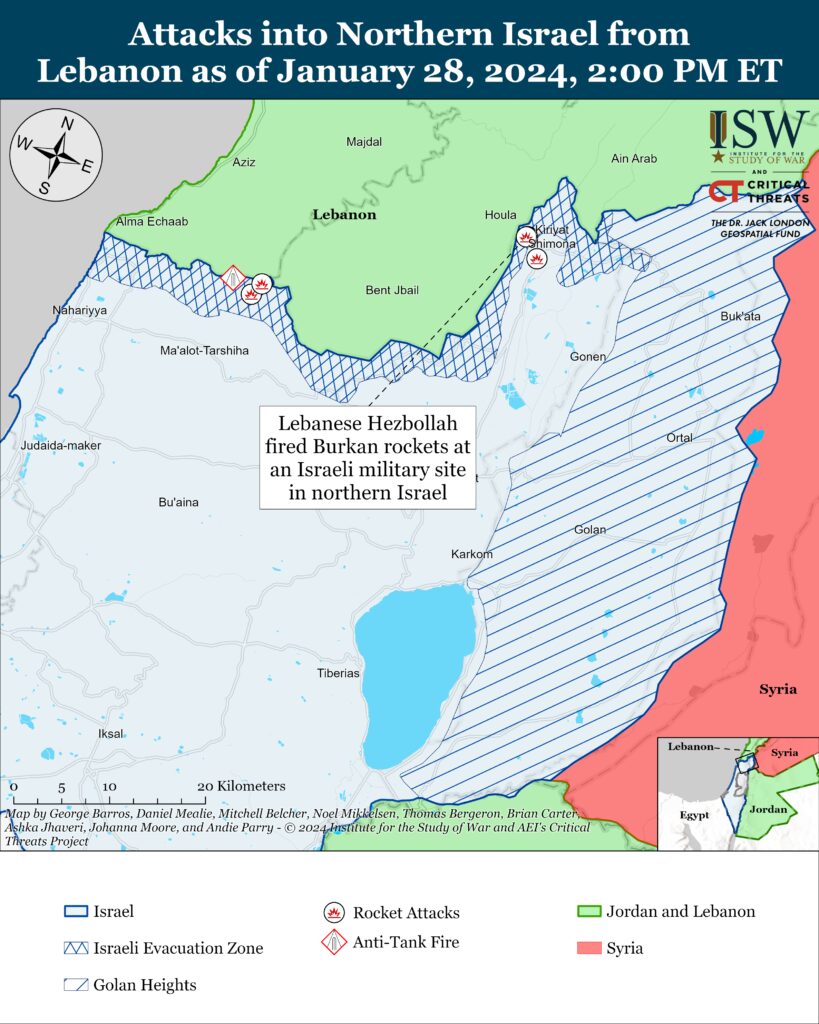
Recorded reports of attacks; CTP-ISW cannot independently verify impact.
Iran and Axis of Resistance
Axis of Resistance campaign objectives:
Demonstrate the capability and willingness of Iran and the Axis of Resistance to escalate against the United States and Israel on multiple fronts
Set conditions to fight a regional war on multiple frontsThe Islamic Resistance in Iraq—a coalition of Iranian-backed Iraqi militias—claimed responsibility for five attacks targeting US positions in Iraq and Syria.[xxv] The group targeted three positions in Syria, one in Jordan, and one in Iraq.
See the topline for coverage on the Islamic Resistance in Iraq attack into Jordan.
The Islamic Resistance in Iraq claimed that it fired unspecified munitions at an Israeli military site in Zuvulun, Israel.[xxvi] The group has claimed two other attacks targeting Israel in recent days.[xxvii]
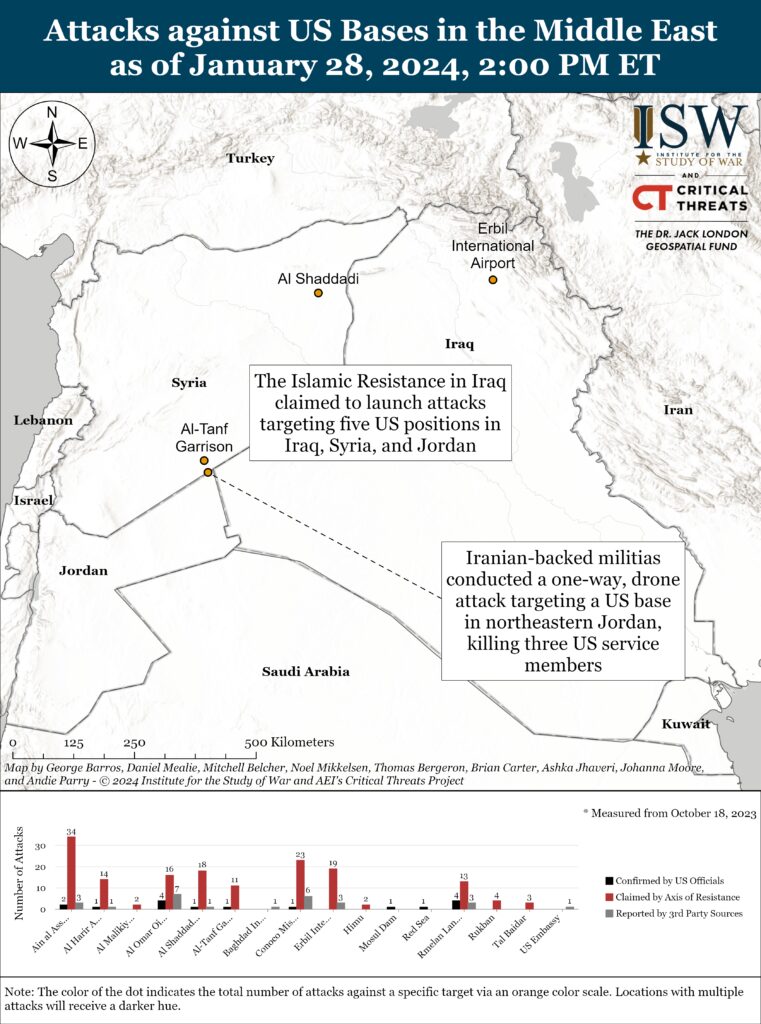
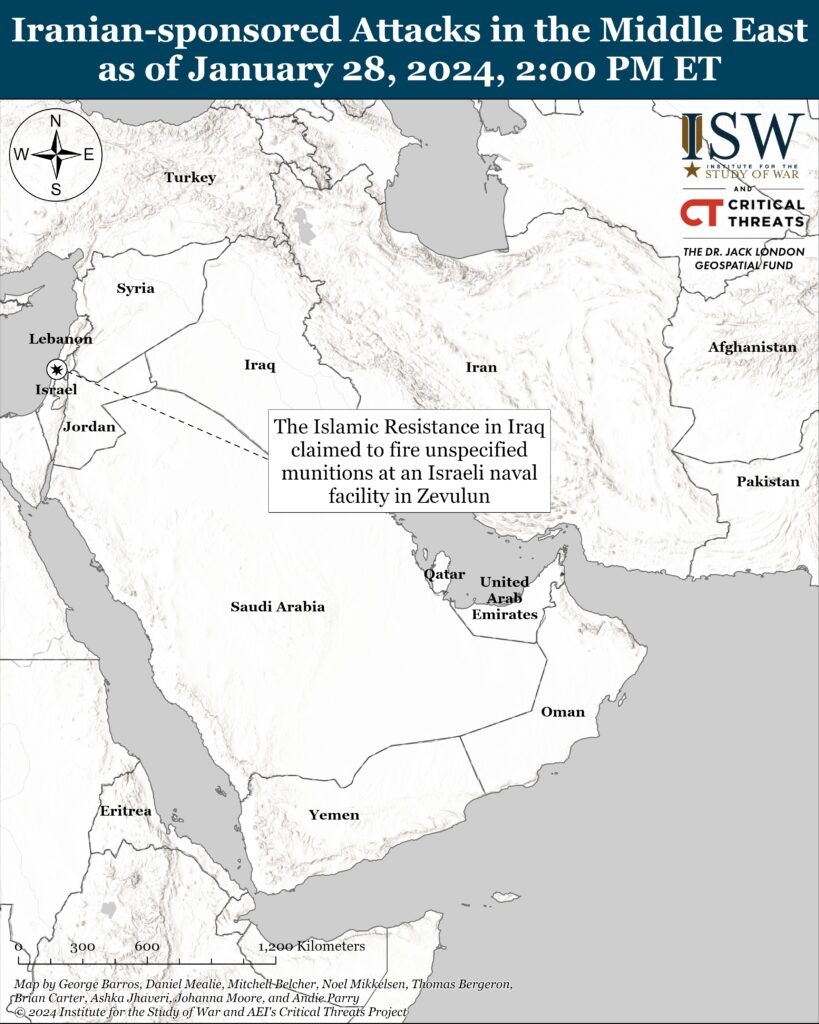
 Eurasia Press & News
Eurasia Press & News

